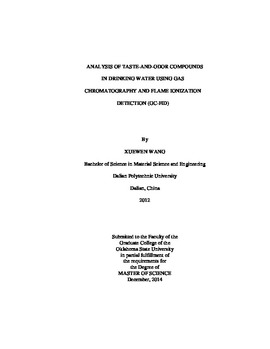| dc.contributor.advisor | Wilber, Gregory G. | |
| dc.contributor.author | Wang, Xuewen | |
| dc.date.accessioned | 2016-01-20T15:45:08Z | |
| dc.date.available | 2016-01-20T15:45:08Z | |
| dc.date.issued | 2014-12-01 | |
| dc.identifier.uri | https://hdl.handle.net/11244/25731 | |
| dc.description.abstract | Geosmin (GSM) and 2-methylisoborneol (2-MIB) are known to cause taste and odor problems in water. This study investigated the usefulness of a SPME-GC-FID method for analyzing aqueous geosmin and 2-MIB and better understanding the capacity of a copper-based algaecide for controlling these compounds in a drinking water treatment process.Analysis of geosmin and 2-MIB are possible with a standard SPME-GC-FID method, although the method sensitivity is at or slightly above the odor threshold concentrations. This renders the method less useful for situations with very low concentration, but it was still confirmed to be a rapid and reliable method. The detection limit of GC-FID can reach the threshold (25 ng/l) of these compounds. The copper-based algaecide did show a potential for removing 2-MIB, but the variables that control its reaction rate remain unknown. For the recommended dosage of 1.188�10-9 mg/l, no significant difference was found, even though the 2-MIB showed a slow decrease to about 18%. In another experiment which the algaecide dosage was doubled, both GSM and 2-MIB exhibited a slight decrease. These results indicate that an acidic, copper algaecide does result in reductions in 2-MIB, but not at the rate observed in the full-scale plant. It is concluded that one or more additional factors plays a role in the reaction, a factor not present in the bench-scale experiments. | |
| dc.format | application/pdf | |
| dc.language | en_US | |
| dc.publisher | Oklahoma State University | |
| dc.rights | Copyright is held by the author who has granted the Oklahoma State University Library the non-exclusive right to share this material in its institutional repository. Contact Digital Library Services at lib-dls@okstate.edu or 405-744-9161 for the permission policy on the use, reproduction or distribution of this material. | |
| dc.title | Analysis of Taste-and-odor Compounds in Drinking Water Using Gas Chromatography and Flame Ionization Detection (Gc-fid) | |
| dc.type | text | |
| dc.contributor.committeeMember | Wilber, Gregory G. | |
| dc.contributor.committeeMember | Veenstra, John N. | |
| dc.contributor.committeeMember | Sanders, Dee Ann | |
| osu.filename | WANG_okstate_0664M_13768.pdf | |
| osu.accesstype | Open Access | |
| dc.description.department | Civil Engineering | |
| dc.type.genre | Thesis | |
